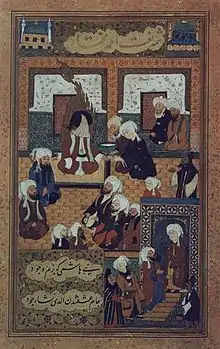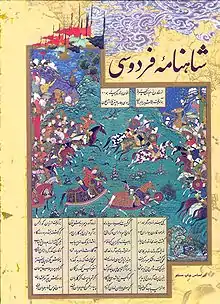Companions of the Prophet
Companions of the Prophet or aṣ-ṣaḥābah (Arabic: اَلصَّحَابَةُ meaning "the companions", from the verb صَحِبَ meaning "accompany", "keep company with", "associate with") were the disciples and followers of Muhammad who "saw or met the prophet during his lifetime and were physically in his presence".[1] "Al-ṣaḥābah" is definite plural; the indefinite singular is masculine صَحَابِيٌّ (ṣaḥābiyy), feminine صَحَابِيَّةٌ (ṣaḥābiyyah).
Sahabah | |
|---|---|
اَلصَّحَابَةُ | |
 Calligraphic representation of Sahabah | |
| Known for | Companions of Muhammad |

| Part of a series on |
| Muhammad |
|---|
 |
|
Later scholars accepted their testimony of the words and deeds of Muhammad, the occasions on which the Quran was revealed and other various important matters of Islamic history and practice. The testimony of the companions, as it was passed down through trusted chains of narrators (isnads), was the basis of the developing Islamic tradition. From the traditions (hadith) of the life of Muhammad and his companions are drawn the Muslim way of life (sunnah), the code of conduct (sharia) it requires, and the jurisprudence (fiqh) by which Muslim communities should be regulated.
The two largest Islamic denominations, the Sunni and Shia, take different approaches in weighing the value of the companions' testimonies, have different hadith collections and, as a result, have different views about the ṣaḥābah.[2]
The next generation of Muslims after the ṣaḥābah, who were born after Muhammad died but knew personally at least one ṣaḥābah, are called Tābi‘ūn, and the generation after them, who knew at least one Tābi‘, are called tābi‘ al-tābi‘īn.[3] The three generations make up the salaf of Islam.

Types of ṣaḥābah
In Islām, companions of Muḥammad are classified into categories including the Muhajirūn[lower-alpha 1] who accompanied Muhammad from Mecca to Medina, the Anṣār who lived in Medina, and the Badriyyūn who fought at the Battle of Badr.[2][lower-alpha 2][lower-alpha 3]
Two important groups among the Companions are the Muhajirūn "migrants", those who had faith in Muhammad when he began to preach in Mecca and who fled with him when he was persecuted there, and the Anṣār, the people of Medina who welcomed Muhammad and his companions and stood as their protectors.[lower-alpha 4][lower-alpha 5]
Lists of prominent companions usually run to 50 or 60 names, the people most closely associated with Muhammad. However, there were clearly many others who had some contact with Muhammad and their names and biographies were recorded in religious reference texts such as ibn Sa'd's early Book of the Major Classes. Al-Qurtubi's Istīʻāb fī maʻrifat al-Aṣhāb, who died in 1071, consists of 2770 biographies of male and 381 biographies of female ṣaḥābah.
According to an observation in al-Qastallani's Al-Muwahib al-Ladunniyyah, an untold number of persons had already converted to Islam by the time Muhammad died. There were 10,000 by the time of the Conquest of Mecca and 70,000 during the Expedition of Tabuk in 630. Some Muslims assert that they were more than 200,000 in number: it is believed that 124,000 witnessed the Farewell Sermon Muhammad delivered after making Farewell Pilgrimage to Mecca.
Differing views
Sunni Muslim
The most widespread definition of a companion is someone who met Muhammad, believed in him, and died a Muslim. The Sunni scholar ibn Hajar al-Asqalani (d.852 H) said,
The most correct of what I have come across is that a Sahâbî (Companion) is one who met the Prophet Muhammad ﷺ whilst believing in him, and died as a Muslim. So, that includes the one who remained with him for a long or a short time, and those who narrated from him and those who did not, and those who saw him but did not sit with him and those who could not see him due to blindness.[4]
Anyone who died after rejecting Islam and becoming an apostate is not considered as a companion. Those who saw him but held off believing in him until after his passing are not considered ṣahābah but tābiʻūn. . According to Sunni scholars, Muslims of the past should be considered companions if they had any contact with Muhammad, and they were not liars or opposed to him and his teachings. If they saw him, heard him, or were in his presence even briefly, they are companions. All companions are assumed to be just (ʻudul) unless they are proven otherwise; that is, Sunni scholars do not believe that companions would lie or fabricate hadith unless they are proven liars, untrustworthy or opposed to Islam.[5]
Some Quranic references are important to Sunni Muslim views of the reverence due to all companions;[6][7][8][9][10][11][lower-alpha 6][lower-alpha 7][lower-alpha 8][lower-alpha 9] It sometimes admonishes them, as when Aisha, daughter of the first Sunni caliph Abu Bakr and the wife of Muhammad, was accused of infidelity. [lower-alpha 10][lower-alpha 11]
Differing views on the definition of a Companion were also influenced by the debate between the Traditionalists and the Muʿtazila with the traditionalists preferring to extend the definition to as many people as possible and the Mu'tazilites preferring to restrict it.[12]
Shia Islam
The Shia[13][14] as well as some Sunni scholars like Javed Ahmad Ghamidi and Amin Ahsan Islahi state that not every individual who met or had accidentally seen Muhammad can be considered a Companion. In their view, the Qurʻan has outlined a high level of faith as one of the distinctive qualities of the ṣaḥābah. Hence, they admit to this list only those individuals who had substantial contact with Muhammad, lived with him, and took part in his campaigns and efforts at proselytizing.[15] In other words, Companion is called to sahaba of prophet who be in a long-term relationship with him and support him in essential event up to their death.[14]
In view of such admonitions, the Shia have different views on each ṣaḥābiyy, depending on what they accomplished. They do not accept that the testimony of nearly all ṣaḥābah is an authenticated part of the chain of narrators in a hadith and that not all the ṣaḥābah were righteous just because they saw or were with Muhammad. The Shia further argue that the righteousness of ṣaḥābah can be assessed by their loyalty towards Muhammad's family after his death and they accept hadith from the Imams of the Ahl al-Bayt, believing them to be cleansed from sin through their interpretation of the Qurʻan[lower-alpha 12] and the hadith of the Cloak.
Shia Muslims believe that some companions are accountable for the loss of caliphate by the Ali's family.[1]
As verses 30-33 from Al-Aḥzāb, Shias believe their argument that one must discriminate between the virtues of the companions by verses relating to Muhammad's wives.[lower-alpha 13]
Baháʼí Faith
The Baháʼí Faith recognises the companions of Muhammad. They are mentioned in the Kitáb-i-Íqán, the primary theological work of the Baháʼí religion.[16]
Hadith
Sunni views
According to the History of the Prophets and Kings, after the death of Muhammad, Abu Bakr, Umar and Abu Ubaidah ibn al-Jarrah and the Anṣār of Medina held consultations and selected Abu Bakr as the first caliph. Then 'Abd al-Rahman ibn 'Awf and Uthman, companion and son-in-law of Muhammad and also essential chief of the Banu Umayyah, selected Umar as the second caliph after the death of Abū Bakr and the other Anṣar and Muhajirun accepted him.[17][18]
Sunni Muslim scholars classified companions into many categories, based on a number of criteria. The hadith quoted above[lower-alpha 14][lower-alpha 15] shows ranks of ṣaḥābah, tābi‘īn, and tābi‘ at-tābi‘īn. Al-Suyuti recognized eleven levels of companionship.
Shia views
Following the consultation of companions about the successor of Muhammad, Shi'i scholars, therefore, deprecate hadith believed to have been transmitted from alleged unjust companions and place much more reliance on hadith believed to have been related by Muhammad's family members and companions who supported Ali. The Shia claim that Muhammad announced his successor during his lifetime at Dawat Zul Asheera[19] then many times during his prophethood and finally at the event of Ghadir Khumm.[20]
Shias consider that any hadith where Muhammad is claimed to have absolved all ṣaḥābah from sin is a false report by those who opposed the Ahl al-Bayt.[21]
See also
Notes
- Qur'an, 8:72
- Qur'an, 3:103
- Qur'an, 48:29
- Qur'an, 9: 100
- Qur'an, 9: 117
- Qur'an, 48:10
- Qur'an, 8:74
- Qur'an, 8:75
- Qur'an, 57:10
- Qur'an, 24:11-16..."Indeed, those who came with falsehood are a group among you. Do not think it bad for you; rather it is good for you. For every person among them is what [punishment] he has earned from the sin, and he who took upon himself the greater portion thereof - for him is a great punishment. Why, when you heard it ..."
- Qur'an, 9:101 "And among those around you of the bedouins are hypocrites, and [also] from the people of Madinah. They have become accustomed to hypocrisy. You, [O Muhammad], do not know them, [but] We know them. We will punish them twice [in this world]; then they will be returned to a great punishment"
- Qur'an, 33:33
- Qur'an, 33:30-33
- Sahih al-Bukhari, 3:48:820
- Sahih Muslim, 31:6150
References
- Encyclopaedia Britannica (2008). Britannica Concise Encyclopedia. Encyclopaedia Britannica, Inc. p. 441. ISBN 978-1-59339-492-9.
- The Editors of Encyclopaedia Britannica. "Companions of the Prophet". britannica.
- Esposito, John L. (2003). The Oxford Dictionary of Islam. Oxford University Press. p. 301. ISBN 9780195125597. Retrieved 9 March 2019.
- [Source: Al-Isâbah (1/4-5) of al-Hâfidh lbn Hajar]
- Muhammad ibn Ahmad (died 1622), also known as "Nişancızâde", Mir’ât-i kâinât (in Turkish):
Once a male or female Muslim has seen Muhammad only for a short time, no matter whether he/she is a child or an adult, he/she is called a Sahaba with the proviso of dying with as a believer; the same rule applies to blind Muslims who have talked with the Prophet at least once. If a disbeliever sees Muhammad and then joins the Believers after the demise of Muhammad, he is not a Sahaba; nor is a person called a Sahaba if he converted to Islam afterward although he had seen Muhammad as a Muslim. A person who converts to Islam after being a Sahaba and then becomes a Believer again after the demise of Muhammad is a Sahaba.
- "Sharh al-`Aqeedah at-Tahaawiyyah", by al-Tahawi, p.526-528
- "Al-I`tiqad `ala Madhhab al-Salaf Ahl al-Sunna wa al-Jama`a", by Al-Bayhaqi, pg.109–113
- "Al-Tajrid fi Asma' al-Sahaba", by Al-Dhahabi, pg.57
- Word Games With Verse 33:33, By: Ibn al-Hashimi
- Mothers of the Believers, By: Ibn al-Hashimi
- Al-Ifk: Quran Defends Aisha, By: Ibn al-Hashimi
- Jabali, Fu'ad (2003). The Companions of the Prophet - A Study of Geographical Distribution and Political Alignments. Brill. p. 46. ISBN 978-90-04-12923-8.
- Jabali, Fu'ad. "A STUDY OF THE COMPANIONS OF THE PROPHET: GEOGRAPHICAL DISTRlBUTION AND POLITICAL ALIGNMENTS (1999)" (PDF). nlc-bnc.ca.
- Taqi poor, Hussain. "reviewing of the article "Companions of the Prophet" authored by linda L. Kim". noormags.
- Fundamentals of Hadith Interpretation by Amin Ahsan Islahi
- Bahá'u'lláh (189x). The Kitáb-i-Íqán (1989 pocket-size ed.). US Baháʼí Publishing Trust. Archived from the original on 2015-01-08. Retrieved 2014-12-29 – via Bahá’í Reference Library.
- Fitzpatrick, Coeli; Walker, Adam Hani (2014). Muhammad in History, Thought, and Culture: An Encyclopedia of the Prophet of God [2 volumes]. ABC-CLIO. p. 566. ISBN 978-1-61069-178-9.
- Afsaruddin, Asma. "Companions of the Prophet (2008)". oxford islamic studies.
- Burton, Sir Richard (1898). (The Jew the Gypsy and El Islam. San Francisco.
- Razwy, Sayed Ali Asgher. A Restatement of the History of Islam & Muslims. p. 276.
- Hadi, Muhammad. "Companions of the Prophet in view of Quran and Imams". noormags.
Further reading
- Osman, Amr, Companions, in Muhammad in History, Thought, and Culture: An Encyclopedia of the Prophet of God (2 vols.), Edited by C. Fitzpatrick and A. Walker, Santa Barbara, ABC-CLIO, 2014.
- Ibn Sa'd al-Baghdadi, Muhammad – The book of The Major Classes, only partially translated into English; see Men of Medina and Women of Medina published by Ta-Ha Publishers, and first two volumes as published by Kitab Bhavan, New Delhi.
- Wilferd Madelung – The Succession to Muhammad, Cambridge University Press, 1997.
- Maxime Rodinson – Muhammad, 1961, as translated into English and published in 1980 by Pantheon Books.
- William Montgomery Watt – Muhammad at Medina, Oxford University Press 1956.
External links
| Wikiquote has quotations related to: Companions of the Prophet |